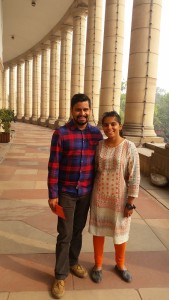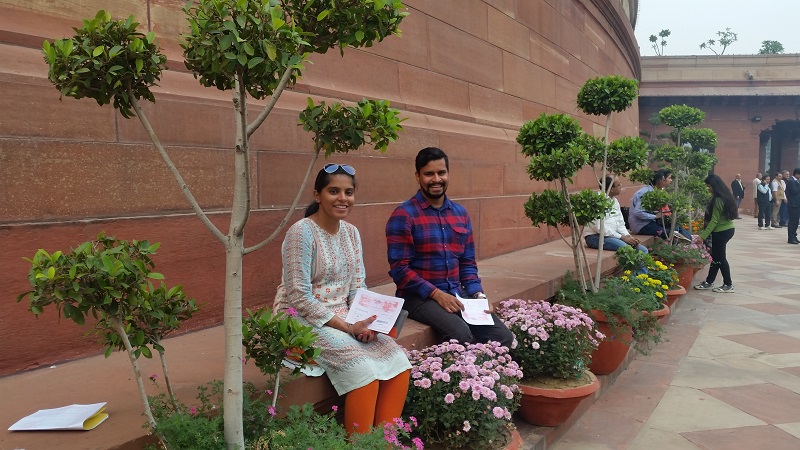Background Story
Though we live in Australia, I have always kept a close watch on Indian politics. One of the main reasons for my interest is that the democracy in India is huge and can be very interesting during election period in various states, especially those which are more populous than most countries in the world.
Shruti’s brother-in-law happens to be a journalist for a TV channel within the Indian Parliament. He invited us to visit the Parliament and watch sessions of Parliament in both houses, Rajya Sabha (upper house) and Lok Sabha (lower house). Though we were tight on time, we couldn’t say no!
Tight Security
Indian Parliament was attacked in December 2001 by terrorists belonging to Jihadi elements based in Pakistan. Since then, the security is very tight. In all, I was frisked at least 5 times, sometimes twice at a time. Everything we had on us was either put in the car or given to our bro-in-law. Well, maybe my bearded look factored in severe security check too, though I can’t be sure about it.
We waited in the reception office of the Parliament which is the first stop for those visiting the building. The room was circular with varnished wood furnishings. There was a sales counter for the publications provided by both houses of the Parliament. Though I have not been to too many government buildings, one could feel this place was different.
I have to mention, there was a drinks counter sponsored by Himachal Pradesh, serving apple, lychee and orange juices. They were YUM!
Tour of Parliament
As it happens, holding a foreign passport in India causes issues at government buildings. This was no different in the Parliament, the power house of the country. Our bro-in-law had to run around to get MP’s signatures and then push for my foreign resident clearance so we could enter.
Luckily, the tour of the Parliament was allowed for most people, foreign or otherwise. The feeling we had as we walked closer to the Parliament was equivalent to walking on to the stage of a Bollywood movie set or a LA movie studio. Generations of India’s rulers such as the Gandhis and legendary politicians such as Jawaharlal Nehru, A. B. Vajpayee, Lal Bahadur Shastri, L. K. Advani, Chadhary Charan Singh and many more had walked through this building. Perhaps our connection with India gave us a feeling of nervousness and excitement.
Additionally, my interest in politics showcased when politicians walked in and out of the building and I could name most of them. Shruti did make a couple of faces as she hardly knew any of them.
 We walked next to the famous beams and rooms which are visible from the outside. Majority of the Parliament is constructed from the red and white sandstone making it similar to Red Fort with a different architectural style. The rooms on the outside circle of the Parliament have name plates of current ministers, this made us exited each time we recognized a name.
We walked next to the famous beams and rooms which are visible from the outside. Majority of the Parliament is constructed from the red and white sandstone making it similar to Red Fort with a different architectural style. The rooms on the outside circle of the Parliament have name plates of current ministers, this made us exited each time we recognized a name.
We saw the entry to Lok Sabha, Rajya Sabha and the Central Hall used for joint sittings. Perhaps, we were able to see a little more of the Parliament than most people and we are grateful for it. To cap off the tour, we had a thali at the canteen inside.
Subsidised Food
Both the reception office and the part of the Parliament we accessed had a canteen. It is possible that there are a few more canteens in the premises. What is common to these canteens is that the food is extremely cheap. A vegetarian thali was 25-30 rupees while kheer (rice pudding) was 5 rupees. The non-vegetarian food was around 40 rupees making it heavily subsidised. An average thali outside in public would cost at least 100 rupees.
Rajya Sabha
We finally got the pass to enter Rajya Sabha at 3 pm. We were ushered to our seats by parliamentary employees. The Rajya Sabha is the upper house of Parliament where the MPs have been elected by members of state assemblies. However, 14 members of Rajya Sabha have been nominated the President after recommendations by the Central government. They are usually well informed on a subject and the country expects them to use this knowledge when passing bills.
The room is semi circular with red/maroon carpet. The ceiling has an eye like structure which is possibly to let the MPs know that the nation is watching. During our time in the RS, the debate was over the constitution and what it has achieved. The tone of debate was friendly and intelligent.
The only let down were the security officials who had a certain idea about how the visitors should behave. One could not lean forward, talk, stand up or even sit with one leg over the other. While some of these rules made sense, others were not needed.
Lok Sabha
Lok Sabha is the lower house of the Parliament. There are 543 MPs in this house who have been elected from all parts of the country. The carpet of the house is green and the house is much larger than the Rajya Sabha. On the ceiling, there is a semi circular Dharma Chakra, Buddhist Wheel of Dharma, which exists on the Flag of the Nation as well.
While at the LS, we found out that the PM would be giving a speech at 5pm. Our initial time was 4-5pm and we would miss the speech if we went by that. Our host somehow had the time extended and we got to see the full speech of the Prime Minister of 1.3 billion people.
The power of the people could be felt in the room. To be fair, LS is a bit like India itself. It is incredibly varied with all racial, linguistic and religious identities represented. The level of debate is lower than that of the RS and very much like India outside, chaos could take place at any time.
MPs hold their breath as each MP speaks like a lioness in the savannah ready to chase its prey at any moment. A slight mistake in language or accusation towards the main parties or a senior leader can lead to huge argument which may force the speaker of the house to adjourn the session.
Our host explained to us that as journalists they watch before and after the sessions more than the sessions themselves to see which MPs are close to each other and who are against each other. We left at 6pm from LS having spent the entire day in the Parliament. Overall, it was a power day at Indian Parliament.
Speeches
As stated, we had the opportunity to hear speeches in both the houses. The speeches in Rajya Sabha had a professional outlook to them. The MPs spoke with a calm tone with an insight into the subject of the constitution. More importantly, the MPs of other parties listened without causing any interruption though many MPs were wandering around passing messages to each other. However, it doesn’t mean there wasn’t any shadow boxing between the parties with the TMC candidate refusing to let the leader of their rival CPI-M speak first.
Sharad Yadav of the JDU from Bihar had a long speech in the Rajya Sabha which combined ranting with some cruel facts. The crux of his speech as I understood was that even after 6 decades of the adoption of the constitution, there were only a handful of senior level bureaucrats from the lowest or formerly untouchable castes. This was retorted by the Mukhtar Abbas Naqvi of the BJP who put the figure at 4 currently. Moreover, he claimed that the sanitation workers in the parliament itself were underpaid despite Dr Ambedkar wanting to uplift the lowest Indians. It may be some indication of the current media culture that despite raising some serious concerns, the highlighted part in the media was he called the country ‘Pakhandi’ or ‘Hypocrite’.
Lok Sabha on the other hand was more rough. MPs were heckled and yelled at when they raised a controversial point or applauded when it suited the agenda of the opposition. It was evident that the major parties used strong arming tactics in the parliament. Independent MPs and MPs of smaller parties received minimal amount of time to voice their opinion while the major parties received the lion’s share. The PM Modi’s speech centred around Dr Ambedkar and the constitution of India.
In it, he highlighted that the constitution was the ultimate document for the path for India. Ambedkar used his compassion in his work despite being abused all his life, he made a fair constitution which has lasted so long. In a gesture of compromise with the opposition, he used soft language towards the leaders of the Congress and used language which would unite the two parties. For the most part, the opposition also showed respect as needed to a PM.
In conclusion, the speeches though centering on a mutually agreed topic, showed the tactics and skills used in the parliament. It all seemed like a sport where the stronger opponent would catch the weaker opponent napping. Somewhat similar to ‘House of cards’, the houses had friends, enemies and work colleagues just like any other workplace though this place was deciding the future of India.
Summary
Final Thoughts
It was a little last minute but we loved every minute of it. To my surprise, Shruti found it quite exciting almost like visiting the Emmy’s and spotting celebs.
Both at lunch time and after the sessions finished, we got to watch the ‘house of cards’ style media game taking place outside the Parliament. Journalists and politicians are strange bedfellows who both need each other but also need to be separate for the benefit of the country.
Apart from adding to our list of experiences during the travel, this day would have long term impacts for us. We will look at Indian news channels slightly differently fully aware that there are political games at play beneath the surface. Thoroughly recommended!
Transport
There are a few Delhi Metro stations near the Parliament like Rajiv Chowk and Central Secretariat.


